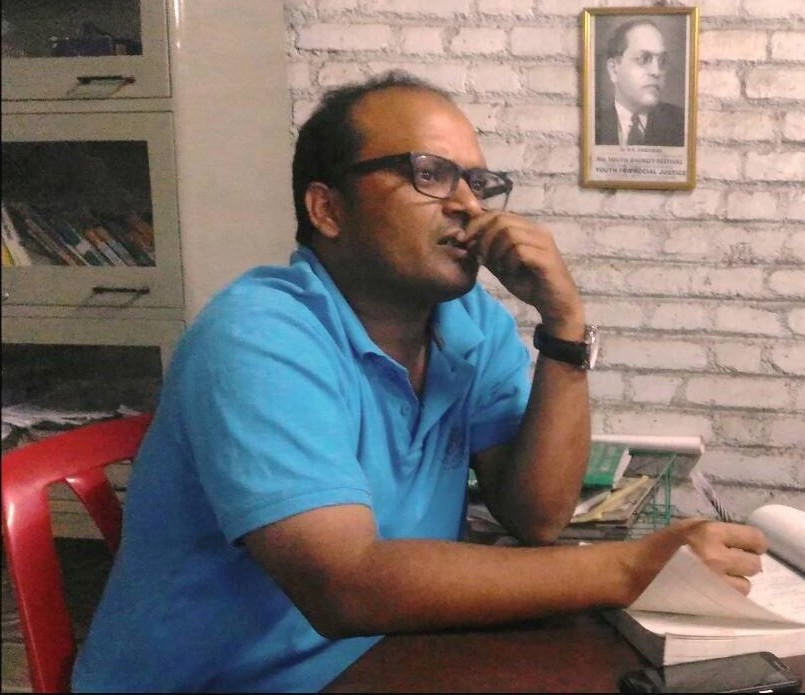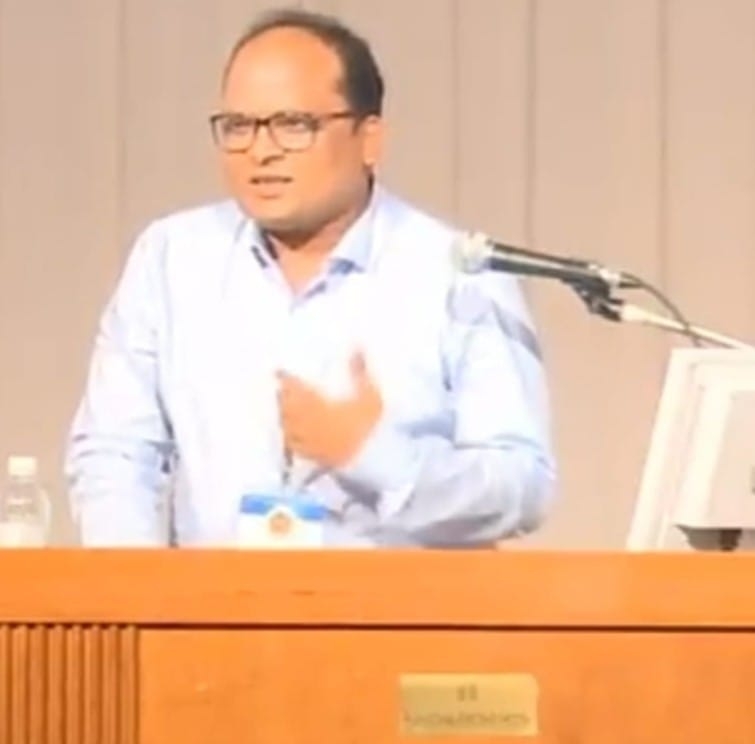Sanjeev Gumpenapalli
 Introduction
Introduction
India’s Adivasis had waged some of the greatest battles in various corners of the country to reassert their right to autonomy and self-determination. While these were characteristically heterogeneous resistance movements, both armed and unarmed, what is common about them is the demonstration of their right over natural resources and also community resources (land, water and forest). In this connection, “Jal Jangal Jameen” was a revolutionary slogan raised by one of the greatest Adivasi leaders, Komaram Bheem, who led the Gondwana movement for an autonomous Gondwana State during the reign of the Nizams. This movement contemplated Tribal Autonomy as liberation from the dikus (Outsiders). Such an autonomy, asserted by the Adivasi populations time and again, seems to have been now scuttled by the Supreme Court through a five-judge bench.
On April 22, 2020, the Constitutional bench of the Apex Court pronounced a judgment in the matter of “Chebrolu Leela Prasad v. State of A.P” (Civil Appeal No: 3609 of 2002, Supreme Court of India), dissolving Go.Ms. No 3 by reason of constitutional disagreement with 100 percent reservation for Scheduled Tribe teachers in schools situated in Scheduled Areas. The Supreme Court’s decision to reverse the Judgment (Pulusam Krishna Murty vs Sujan Kumar 2002 (1) ALD 423, 2002 (2) ALT 77) given by the Andhra Pradesh (Undivided) High Court has created anxiety and uncertainty among Adivasi population in the Scheduled Areas. This Judgment would simply provide a legal invitation for the intrusion of the ‘Non-Tribes’ into the Scheduled Areas and also, this may be even seen as a threat to the entire ‘Reservation Policy’ and the principle of Social Justice in the Scheduled Areas enshrined in the Constitutional scheme.
The context for the G.O may be recalled, taking us back to the late 1990s, when the lack of legal and political protection to Scheduled Areas had led to deprivation of livelihood, forced migration, human trafficking, displacement, demotion of cultural rights and socio-economic rights by way of land alienation through non-tribal influx. This set the stage for the rights movement that followed it. Following that, in 2000, G.O.Ms. No 3 dated January 10, 2000, that guaranteed 100% reservation to the Scheduled Tribe teachers in the agency/Scheduled areas, had been brought by the state machinery in favour of the Scheduled Tribes for the purpose of developing educational and employment capabilities in such areas. Though its full benefits were not realized by the target groups, it has definitely resulted in filling the gap between their culture and education and promised employment opportunities to local Scheduled Tribes amidst fragile administrative functioning and illegal non-tribal settlements. This new dictum of the Supreme Court reasserts the attitude of Indian Judiciary to appease the popular conscience, and is reflective of the agenda of the “Development through integration” model which has been resisted by various Adivasi groups.
The Scheduled Areas have, on one hand, lost their character drastically by the coercive development policies of the Indian State, and on the other hand, been impoverished due to Cultural Imperialism. As a result, the identity of the Adivasis/Scheduled Tribes, which has been articulated through many movements by Adivasi/Tribal groups, is dehumanized and subordinated culturally, legally, socially, politically and economically in their own land.
The ‘Naga People’s Movement’ in the North East and the ‘Naga Mothers Association’ ferociously resisted the political subjugation, domination and occupation of their land and their people, asserting their right to self-determination and autonomy. The emergence of the Girijana Sangham in Indravelli and the Pathalgadi Movement, a movement for environmental justice, has articulated Tribal Autonomy as ‘freedom’ from non-tribal intrusion into various affairs. The Dongria Kondhs from Odisha resisted the mining projects and questioned the cultural interference of the outsiders. The Kani tribe of Western Ghats asserted their autonomy over their ‘Traditional Knowledge’ as a part of their cultural right. From the uprising of the Bhils and the Munda uprising to the recent legal land battles have led to the understanding that Tribal Autonomy is multi-faceted and needs to be read as nothing but constitutional. Thus, this new judgment stands in violation of many legal norms – customary, national, and international. It legitimizes the infiltration of non-tribals which is a potential threat to the right to Tribal Autonomy.
Now, one by one in detail, let us look into the adverse effects that the Judgment might cause, how the many facets of Tribal Autonomy are affected and how the influx of the non-tribes is made legal by this judgment.
Land – Cultural Autonomy
Land is the foremost natural resource and a dominant facet in discussing autonomy. Para 5(2) of the Fifth Schedule lays out the express intentions of the Constitution of India to safeguard the land belonging to Scheduled Tribes in the Scheduled Areas. However, illegal land alienation is a grave concern in the Scheduled Areas, as it had forced the Adivasis into a vicious circle of insecurity, which is very unnatural to the traditional socio-economic organization of the Adivasi populations. A 2002 study by Kamal K. Mishra reveals that the illegal tribal land alienation in the Scheduled Areas is as high as 85.95 percent in Undivided Andhra Pradesh and Madhya Pradesh. As a consequence, it has disturbed well-knit communities and their cultural threads.
The protective Land Transfer Regulation Act, 1970, that survived judicial review twice, has provided for complete prohibition of sale and transfer of land in Scheduled Areas by tribals to non-tribals, and non-tribals to non-tribals. The land restrictions are related to the prohibition of infiltration for the enforcement of the right to livelihood of a Scheduled Tribe in a Scheduled Area, since non-tribal infiltration, including the interference of the State ( Samata v. State of A.P), has caused commodification of the land of the Adivasi population, illegal land occupation and alienation affecting survival, socio-economic and cultural rights of Adivasis attached to it. While infiltration into Scheduled Areas is prevented legally and its prohibition upheld as constitutional by the Supreme Court in various cases, it is quite alarming that the Supreme Court through this judgement provides rights to non-tribals in Scheduled Areas against the constitutional commitment in the pretext of bringing Tribals into the mainstream. Hence, this judgement dilutes the purpose (prohibition of infiltration) of land protective laws in Scheduled Areas and makes legal protection of Scheduled Tribes more uncertain.
Traditional Knowledge and Ecology – Cultural Autonomy
Acculturation under the guise of integration preferred by the majority of the non-Adivasi Constitution makers, as against the idea of ‘autonomy’ in the constitutional scheme proposed and argued by Jaipal Singh Munda (the only Adivasi representative in the Constituent Assembly), has resulted not in ‘Integration’ but in the peril of ‘Assimilation’ (proposed by Ghurye). Speaking strictly, ‘Isolation’ proposed by Verrier Elwin (an anthropologist who studied the Baigas) had no trace of effect in the policy making, and later policies forced the Adivasi self-reliant community resource and its traditional knowledge co-operative economy into the monetary based exploitative and competitive one.
Express legal protection has also been provided to Culture, including traditional indigenous knowledge systems, like with the PESA (Panchayat Raj Extension to Scheduled Areas) Act, 1996, upholding traditional knowledge systems of the Adivasi and recognizing that Adivasi cultures are distinct and need to be protected.
Traditional knowledge systems and the phenological knowledge that form the base of the Adivasi economy and subsistence are being rampantly commercialized, posing a grave threat to them. One such famous instance is seen in the Kani tribe of Western Ghats. Such grave violation of the intellectual property regime of the indigenous populations in India affected the forest-based economy run by the Kani tribe which had to face the loss of forest and land under the cultivation of the arogya pacha plant.
The cultural impact sent ripples through the ecology of the Adivasi populations. The developmental projects taken up by discarding the Adivasis and their ecology, due to flawed rehabilitation policies and ill informed Social and Environmental Impact Assessment policies along with the non-implementation of the laws protecting and preserving Adivasi interests, disrupted the fabric of the intrinsic cultural values that plays a vital role in their survival and social systems. In another case, Supreme Court in Orissa Mining Corporation Limited v. Ministry of Environment and Forest (WRIT PETITION (CIVIL) NO. 180 OF 2011) finds the importance of the right of Scheduled Tribes and Traditional Forest Dwellers to maintain their “distinctive spiritual relationship with their traditionally owned or otherwise occupied and used lands.” The United Nations Declaration on the Rights of Indigenous Peoples, to which India is signatory, has recognised the protection of cultural and customary rights of the indigenous people.
Disregarding the reality, and on a quite paradoxical note, the Bench while talking about the influx into the Scheduled Areas and the population of non-tribes being more than the population of Scheduled Tribes in Scheduled Areas, has committed a blunder in realizing its duty to correct the historical wrong and its continuance. The reasoning adopted to invalidate 100 percent reservation would violate the principles laid in the Samata Judgment, PESA Act 1996 and also defeats the entire purpose of A.P. Land Transfer Regulation Act, 1970, that centres protection of Land-Culture Relationship. It would also mean contravening the international legal agreements such as ILO Convention 107 and the United Nations Declaration of Rights of the Indigenous Peoples.
Political Autonomy
“Maa naate maave rajyam” which means “we govern ourselves” has been the crux of many Adivasi led movements. It found place in the Panchayati Raj Extension to Scheduled Areas Act 1996 enabling decentralised self-government by giving decision making power to Grama Sabhas and Tribal Heads in various affairs of the community. Now that the Supreme Court has read the employment opportunities to non-tribals into the Fifth Schedule, it will attract more than ever, with a legal invitation, the interests of the non-tribals, in addition to the already residing 70% non-tribal population. And particularly, the Brahminical capitalist interests that carry the baggage of cultural Hegemony. This has already been proved with a visible hinduisation of tribal culture and recent demands of the non-tribal groups to upgrade the status of certain gram panchayats in Scheduled Areas into Municipalities1. This demand was possible due to a history of infiltration of non-tribals. With the decision against the logic of 100 percent reservation in Scheduled Areas, the spirit of PESA Act stands attacked and similar demands can be made in the future in favour of infiltration of non-tribals.
In the words of Sondi Veeraiah, Adivasi activist and Founder of GSP (Gondwana Samkshema Parishad), “in future this principle against 100 percent reservation will affect political representation as mandated by PESA and will curb political autonomy. The politically powerful non-tribal influx will pose a great danger to the operation of the provisions of PESA Act”.
The counterproductive face of merit argument – Unconstitutional
Education is a culture learning exercise. The close and sensitive communication between a student and teacher encourages enrollment and fills the gap between the curriculum and culture. G.O. 3 serves the purpose of filling all these gaps and opens up a space for the right to information and celebrating cultural learning.
The line of argument taken up by the Supreme Court quoting the lack of merit is nothing but a mockery of the Constitutional spirit and the principles of Social Justice and Distributive Justice enshrined in the Scheme of Constitution. This supremacist understanding of the concept of meritorious qualifications and its application to the Adivasi land is counterproductive and unconstitutional as well. In the words of Mrs. Aruna Sapaka, Adivasi teacher, co-founder, General Secretary of Aadivasi Mahila Chaitanya Shakthi, “The Supreme court decision upholding the appointment of non-tribal teachers in the agency areas/tracts on a large scale also affects the promotion of education in both Primary and Secondary school level. The ignorance and lack of understanding of the Tribal culture by the non-tribal teachers hinders the student-teacher interaction. Secondly, a multi-lingual/dialectic kind of education is a must for the promotion of education among the Adivasi children without which the students are discouraged from enrolling themselves into the schools. The most adverse effect is that a substantial increase in the rate of “drop outs” would be the result of promoting the non- tribal teachers in the agency areas arguing the case on merit that would defeat the purpose of the special protection to scheduled areas. Koyathur bata was one such initiative that has to be appreciated and the states must follow similar programmes to enhance the education for skill based-capacity building.” She also states that if the Judiciary is speaking about merit, then every Adivasi teacher who is appointed is now clearing the “competitive exam” that is supposed to decide merit, and such an argument to say there is no merit or enough skill is flawed and highly condemnable. Unemployment among the Adivasi youth would increase and sadly, ‘we do not even have the forests we once had to survive’.
What does the Supreme Court think of the Fifth Schedule?
The obliteration of the Constitutional spirit is very evident in the manner the Supreme Court diverged from the Constitutional position in the case of “Chebrolu Leela Prasad v. State of A.P” (Civil Appeal No: 3609 of 2002, Supreme Court of India).
The interpretation preferred by the Supreme Court of India is neither purposive nor harmonious in nature. The Supreme Court had to resort to the rule of ‘Harmonious Construction’ while looking into the scheme of the Rights conferred under the Fifth Schedule, also known as ‘Constitution within Constitution,’ and other provisions of the Indian Constitution for the administration of Scheduled Areas. In the judgement, the Court has lacked the mind of a State’s organ that is established to fill the gap in the law. The gap-filling exercise is to interpret justice into law. The importance of knowledge around the special constitutional position of the Fifth Schedule plays a major role in interpretation of laws for the purpose of Adivasis in Fifth Scheduled Areas. Without being aware of such distinctions and the significance of the geographical classification done by the constitution itself, distinguishing them from the non-scheduled areas, it is impossible for the courts to do justice that fills gaps in law.
The court has been interpreting the Fifth Schedule in terms of general laws and the general application of laws. It has its mind stuck around the identification of the application of law similar to the general law against the constitutional prescription. What it should have done is to leave the prejudices about Adivasis and to see the Scheduled Areas as a distinct setup without reference to the larger, so-called civilized society. The Supreme Court’s primary discomfort stems from having a problem with the lack of uniformity in constitutional protections which have positioned Scheduled Areas in a special constitutional framework. The court has tried to impose an unnecessary uniformity in reading protections granted by the constitution against its own vision. It needs to contemplate on why there should be a universal application of the Constitution as against the idea of ‘Constitution within Constitution.’ The judgement disrespects the conscience of the community to give no consent for forced integration through the coercive arrangement of contact with the mainstream. Disregarding their decisions to ignore unnecessary development is to assume the role of a superior patron that infantilizes the decision-making power of such groups. The Supreme Court has to find a language that disallows visualisation of Adivasi, tribal identity as everything but ‘persons’. It must avoid enforcing assumptive welfare standards.
The Supreme Court in Pandiri Rami Reddy vs State of A.P ((1988) 22 Reports (SC) 364)) like many laws have centered ‘infiltration of non-tribals’ as a flagrant violation of the character of Scheduled Areas and a problem that needs central focus. As rightly pointed out by Koneru Ranga Rao Committee Report on Land Issues, progressive Constitutional safeguards are not being read in the light intended. Adjudicatory and administrative principles are construed to hinder rather than to further the objective of laws.
Conclusion
We must reconsider the proposal of Jaipal Singh Munda for the protection of the Fifth Schedule by demanding an active role for the Tribal Advisory Council rather than leaving the decisions concerning the Tribal population to a Ruler of a State (still a non-tribal). Such decisions include amendments to the Fifth Schedule and also extending the safeguards to the Tribals elsewhere given the real pandemic of exploitative development and growing commodification of Tribal labour by state sponsored privatisation and the powerlessness of Tribals in public employment sector resulting in displacement of tribals and influx of non-tribals. The Judiciary with the recent judgement has read an express purpose of the Fifth Schedule as unconstitutional.
Critical Legal Studies should emerge as a mandate to the Bar and the Bench. Adivasis have natural rights to their territory and to protect it from non-tribals including the State. Like no natural right is exclusive of one another, employment and education are not exclusive of the right to territory and cultural rights. Fundamental Rights in the constitution need to take a bottom-up approach and be read in favour of the exploited and marginalized in realisation of social justice. Democracy in Indian Judiciary fostering representation of the unrepresented in the Higher and Lower Judiciary will one day Adivasi-ise the bench.
Jal Jangal Jameen will be left to the interests of the Non-tribals if laws like G.O.No.3 become inoperative and eventually lead to the dilution of the Fifth Schedule, directing the Adivasis to remain as a historical case study and a research-able identity than persons of this nation.
~
References
1. Sridhar, P. Bhadrachalam’s municipal status uncertain. The Hindu, November 18, 2017. Available at https://www.thehindu.com/news/cities/Hyderabad/bhadrachalams-municipal-status-uncertain/article20546780.ece
~~~
Sanjeev Gumpenapalli is studying Law and Social Sciences at Nalsar University of Law, Hyderabad. He is a Dalit Adivasi (son of a Koya mother and Madiga father) and is interested in Adivasi Land Rights.










